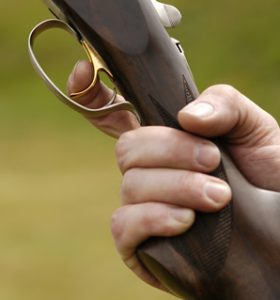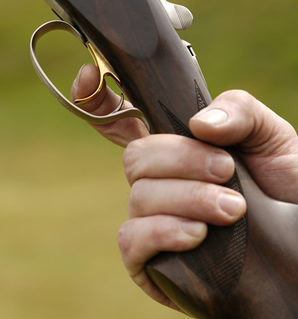I don’t think it has escaped the attention of many women, but girls are different to boys. They are a different shape. They also, quite literally, see the world rather differently. 90% plus of women do not have absolute eye dominance in either eye (though it may appear stronger in one eye than t the other). They are often misdiagnosed as ‘cross-dominant’ – e.g. right-handed but left eye dominant – or as having ‘central vision’ (where neither eye is dominant, but where this phenomenon is constant rather than shifting).
You may not have considered this sort of stuff in any detail before. You may have just got on with your shooting. Fine. But, it is important if you are serious about enhancing both performance and comfort. In fact, it has all sorts of implications for the gun you choose to use. It may indicate how you might improve and modify it, and, it may affect the technique you adopt to shoot.
O.K. let’s continue with some more statements of what might seem obvious (and I noted exceptions because we’re all different). One needs to start somewhere to get across general principles before being more specific. So, where to begin? Women are not usually as tall as men, nor as thick set, and they have less upper body strength on average. Their head and hands are typically smaller, their necks may be longer and their cheek bones more prominent and skin is finer and more sensitive. Please do not take this as sexist in any way, we are just being practical here, and my intention is to make you aware of significant sex differences and how they impact on guns and shooting in a variety of ways.
Women usually – not always – require lighter guns with shorter stocks than men (which can, of course, create problems as most guns are made for Mr 13 1/2 stone 5′ 11” 42 chest Average). Guns must not be too light though. Too light a gun – and many women are mistakenly given excessively light, short-barreled small bores – may become an impediment of themselves (and those women would improve their shooting with slightly heavier guns than they have with barrels which are not too short or heavy). The average women probably wants a gun 1/4-½ lb. lighter than the average man for game shooting. Barrels might be 28 or 30” (if relatively light for length in the latter case). 12 or 20 – personal preference, but it is usually easier to find a mass produced 20 bore more suited to a female shot than a 12 (and, for the record, it is hard to go wrong with a basic Beretta, Browning, Miroku or Guerini over and under 20 with 28 or 30” barrels).
Moving on, the female head is typically smaller than the male so the distance from the centre of the eye orbit to the ‘zygomatic arch’ (the arch of bone that you may feel if you take the pad of your thumb up and feel under the cheek-bone) is less. This suggests in most cases that a female shot will need a gun which is higher in the comb than that required by a man. Without it, she may lose sight of the sighting bead, especially if any cheek pressure is applied and the gun is pointing above the horizontal at a normal shooting angle.
I usually find the average woman needs a stock about 1/4” higher than the average man and an 1” or so shorter. There is, however, massive individual variation: men with small heads, and boys will often need higher stocks too in order to see clearly down the rib, some well-built women with larger heads won’t (and won’t need the short stock either). As with much of what will follow here, the best advice is to get yourself fitted by a pro.
Meantime, if you have a gun already, you can try this experiment. Prove it empty. Now face a wall or safe area and mount the gun horizontally (if you have problems mounting start with the gun stock gently squeezed under your armpit and push it out and up). Don’t be in a rush. Keep your weight on the front foot. Don’t arch your back. As you complete the mount – just before the gun comes up to face and shoulder – shut your eyes, both eyes! Let the gun come to the cheek. Apply normal cheek pressure. Don’t squish your head down. Don’t raise it off the stock comb either!
What do you see? You should be able to see the sighting bead and a little rib whilst your cheek is in positive but not forced contact with the stock comb (the top of the stock). If you are seeing two barrels, by the way, or feel visually confused in any way, it may be that you have both eyes open but, in fact, need to close the eye opposite the rib or obstruct the vision to it. Experiment over. Break the gun, prove it empty and put it down safely.
Time to check eye dominance now. How do you do this? Well it is best to go to a professional instructor who really knows his business in this regard. But, here is the general idea. As noted at the beginning, women who have absolute eye dominance in either eye are a minority. Most women have what I now call indeterminate eye dominance where both eyes compete for control when pointing a gun or finger at a distant object. Testing for eye dominance, meantime, must always be done with real care. It is very easy to misdiagnose eye dominance.
You can test for eye dominance by pointing your index finger, arm extended, both eyes open, at the indicated eye of a friend. You can also do something similar extending your arm and making a circle with your index finger and thumb keeping the arm extended (it’s a little uncomfortable). Get the friend to indicate an eye and look through the circle – they will see which if any eye is dominant (or you may find yourself in a bit of a visual muddle which is easily cured by squinting one eye). Many women find it more comfortable to shut an eye as a means to reduce the visual confusion. Let us also note here though that about 10% of the female population, like 50% plus of men, have absolute eye dominance in the eye looking down the gun rib. And, as with those men, they may be well advised to shoot with both eyes open.
For simplicity, I am going to assume here that you will need shut/squint/wink the eye opposite the rib, or obstruct vision to it (most easily done with a spot carefully positioned on a pair of protective shooting glasses so it only obstructs vision to the eye opposite the rib when your head is on the stock in a firing position). This allows you the use of two eyes to pick the bird up in flight (and get some benefits of binocular vision) and it also allows you the use of two eyes when you are chatting to someone in the field or looking around the gun out of the shoulder. I hate to see girls afflicted with Long John Silver Eye patches – they are unnecessary. It might also be added in explanation that some women find it very difficult to wink or squint an eye (which is the easiest remedy for eye dominance problems). This is why they may need to obstruct vision to the offending eye by artificial means.
O.K. let’s hope we have sorted you out with regard to vision and with a stock which is not too long (keeping it simple I would like to see one to two finger widths of gap between the tip of your nose and the base your thumb when the gun is mounted), and one which has a comb which is sufficiently high for you to see the bead properly when it is normally mounted with positive cheek pressure.
What else do we need to consider? Well, many women need a reduced toe measurement (the back of the stock, called the sole, has a ‘heel’ at the top, and a ‘toe’ at the bottom), especially if they are well endowed. They may not need much of a concave to the rear of the stock as many men do, but much will depend on individual mounting style. I find some women also find a good quality polymer recoil pad a help (those by Kick-Eez are great) and it may be rounded top and bottom (this can help with bra straps too). Some women choose to have an anti-recoil pad fitted in their shooting vest, or may wear a Past type strap-on pad which is worn a bit like a shoulder holster under one’s vest or jacket.
There are some other considerations. The grip of a woman’s gun should not be too thick, nor should the chequering on it or the forend be too coarse. Trigger pulls must not be too heavy either (nor dangerously light), and the safety on the top strap must be positive in action, but not stiff. Finally, I reiterate the fact that everyone – female or male – is different, I have tried to spell out some general principles and ideas here. Ultimately, only you can decide what works best. Don’t assume everything you may have been told is gospel, experiment a bit and trust both experienced advice and your instinct.
Mike Yardley is a Fellow of the Association of Professional Shooting Instructors, the author of Gunfitting the Quest for Perfection for Shotguns and Rifles, and may be contacted via yardleypen@aol.com
